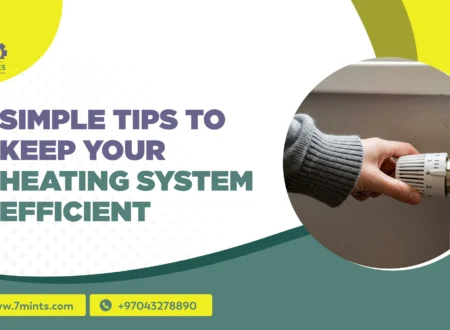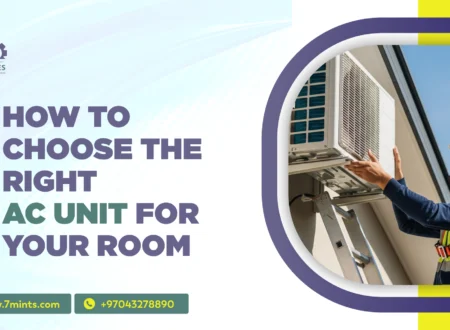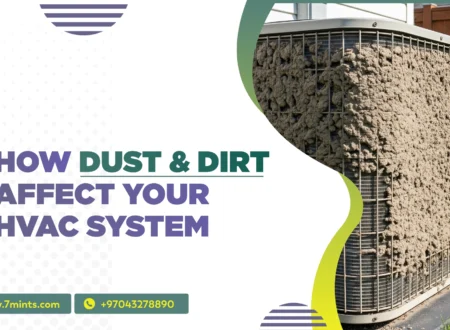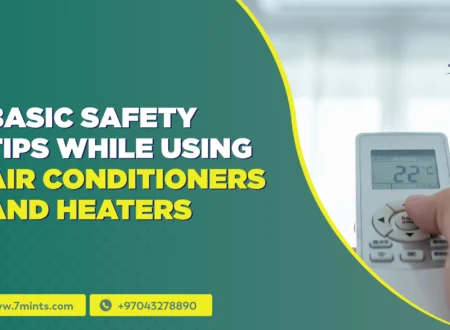IAQ is one of the essential things connected with healthy living and working conditions. Poor air quality ends up triggering many allergies, breathing problems, tiredness, and even long-term health problems. And considering that human beings spend the majority of their time indoors, the cleanliness of the air becomes quite important. HVAC systems are those systems that govern indoor air quality by way of temperature, humidity, and air circulation controls. This blog addresses the avenues to improve the indoor air quality with efficient HVAC solutions and maintenance procedures.
IAQ and HVAC
Indoor air quality is related to air quality inside buildings and their peculiarities, like the presence or absence of dust, molds, allergens, and VOCs (volatile organic compounds). HVAC systems contribute to maintaining healthy indoor air quality by filtration of air, humidity control, and ventilation of areas. When the HVAC system is not taken care of, the air is not at all conducive for health besides comfort, but maintenance of mentored HVAC technologies and regular upkeep will keep you breathing freely and create a healthy indoor environment.
Change or Upgrade Your Air Filters Regularly
This prevents suspended particles from going further into your home or office.
Change the Basic Filters on a Regular Basis
In general, standard fiberglass or pleated filters should be changed every 1-3 months. Dust, pollen, and other particulates clog a filter with time, and obstructed airflow means that the system works harder to push air through it. Hence, the efficiency drops, and contaminants can pass through the filter. Frequent replacements ensure that the system keeps contaminants from the air while also maintaining proper airflow.
Upgrade to High-Efficiency Filters
Filters with higher efficiency, HEPA or MERV II, will capture even smaller particles that would include bacteria and fine dust. HEPA filters can trap 99.97 percent of particles down to 0.3 microns, the kind of filter that is good for allergy sufferers or respiratory disease sufferers. Although it is good to have high-efficiency filters, those filters may restrict airflow if your HVAC system is not made for them. It is advised to consult an HVAC technician before buying a higher efficiency filter, just to confirm if your system can indeed handle it.
Keep Track of Filter Wear
Go on and give your filters a good look every month, irrespective of the replacement schedule you set up. The peak season of use or the presence of pets or smokers within the home should put you on high alert. Just dirt and discoloration, and it’s time for a new filter. Some smart HVAC systems now even suggest when to change your filter, keeping you on top of replacements.
Promote Ventilation and Air Circulation
Ventilation is necessary to extract pollutants from the indoor environment and introduce fresh air.
Use Built-In Ventilation Features
Today, people tend to mix the use of HVAC documentation with that of ERV or HRV, the systems that briefly exchange stale indoor air with fresh outdoor air, with conservation of energy. Such systems help in any way in reducing pollutant build-up indoors but don’t affect heating or cooling costs. The installation of an ERV or HRV should really be considered in tightly sealed homes where natural ventilation is severely limited.
Install Exhaust Fans
Exhaust fans in kitchens and bath areas absorb moisture, odors, and hazardous gases at the source. When these fans are operating during cooking or bathing, they reduce mold development and airborne contamination. Exhaust fans can also be integrated with an HVAC system for more efficient ventilation.
Open Your Windows Whenever Possible
When windows are opened for natural ventilation, indoor contaminants get diluted, and some fresh air enters. When the outside air quality is good, this method is an easy and effective way to increase IAQ. It is best to use natural ventilation alongside the heating system’s air circulation.
Control Humidity Levels
Humidity level helps with comfort and air quality manifestations. Too much moisture will be a perfect home for molds and dust mites, while too little will dry out the air, irritating.
Install Whole-House Humidifiers and Dehumidifiers
Humidifiers add moisture during dry conditions in order to prevent dry skin, static electricity, or respiratory discomfort. Alternatively, whole-house dehumidifiers pull moisture during humid seasons to avoid mold and mildew. Keeping humidity between 30% and 50% seems to offer a comfortable and healthy atmosphere.
Track Indoor Humidity
Hygrometers can track the humidity of each room. Some smart thermostats or HVAC systems even monitor and adjust humidity in real-time; just adjust your settings on the system, or possibly use a portable humidifier or dehumidifier to equalize it as needed. Check out our latest blog post on how AI and IoT Are Transforming Pest Control Services in the UAE
Seal Leaks and Insulate
Air leaks around windows, through doors, and into ductwork allow unwanted moisture to seep in or escape, hampering humidity control. Proper sealing and insulation ensure optimal HVAC operation, with consistent levels of humidity, which contribute to the control of the house against mold and structural damage.
Install Air Purification Technologies
Higher purification methods may eliminate certain pollutants that filters do not.
Install a UV Sterilizer
UV-C sterilizers placed inside your HVAC system kill or deactivate microorganisms like bacteria, viruses, and mold spores as the air passes through, thereby reducing airborne transmission of diseases and improving overall air hygiene.
Ionizers Purifier Options
Ionizers generate ions with a charge that attach themselves to airborne particles, which then clump together and settle out of the air or get trapped in filters. Fewer allergens, less dust, and some pathogens remain in the air. Be aware, however, that some ionizers produce ozone, so choosing models certified to emit safe levels would be prudent.
Activated Carbon Filter Use
An activated carbon filter absorbs gases, odors, VOCs, and chemical fumes that a traditional filter cannot trap. They are especially useful where there is a pet, smoker, or where heavy-duty cleaning chemicals are used. For true air purification, carbon filters should be applied in conjunction with particulate filters.
Regular HVAC Maintenance
It’s essential for maintaining an efficient HVAC system and good IAQ.
Professional Inspections and Tune-Ups
Schedule HVAC maintenance twice a year to clean component parts, check refrigerant levels, inspect ductwork, and test the performance of the HVAC system. Qualified HVAC professionals should identify and fix potential problems before these turn into expensive ones. Also, well-maintained systems will always perform more efficiently and provide better air quality for their users.
Clean and Seal Ductwork
Ducts accumulate dust, mold, and debris, which are circulated through the house. Have the ducts cleaned every 3 to 5 years or much sooner if you observe dust accumulation or faint musty odors. Duct sealing that stops leaks vastly improves work efficiency as well as prevents the entry of contaminants.
Test Indoor Air Quality
During IAQ testing, HVAC companies sometimes measure the levels of particulates, VOCs, humidity, or other pollutants. These test results pinpoint exact problems, moving you one step closer to possible solutions such as upgrading the filters, purifiers, or ventilation system.
Conclusion
Medical hospitality improves indoor air quality, in turn protecting health and comfort. Regular filter replacement, ventilation enhancement, humidity control, application of purification technologies, and system maintenance will establish a clean and safe indoor environment. The air you breathe is worth not having any compromises—start now in improving your indoor air quality!
Are you ready to breathe cleaner air? Contact us immediately to get a free assessment of indoor air quality and to learn about HVAC solutions best suited for your home or business!










1 Comment
Comments are closed.